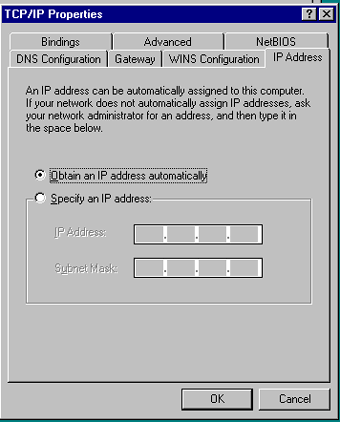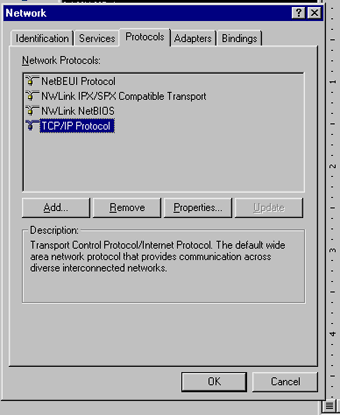Configuring your workstations for
DHCP
Workstations on your network must be configured to communicate with servers
via the Dynamic Host Configuration Protocol (DHCP) before you realize the
benefits of automated TCP/IP address management. In this article, we'll show you
how you can configure Windows 95/98, NT Workstation 4.0, MacOS, and OS/2 Warp
clients to run DHCP effectively.
Installing DHCP on Windows 95 and 98 clients
Chances are that most of the workstations on your network run some version of
Microsoft's retail OS kernel, either Windows 95 or the recently released Windows
98. Fortunately, configuring Windows 95 and 98 to use DHCP is simply a matter of
tweaking options for the TCP/IP protocol.
Verifying TCP/IP
First, check your workstation to make sure it's already running the TCP/IP
protocol. You can verify this by right-clicking Network Neighborhood and
selecting Properties. When the Network dialog box's Configuration tab appears,
scroll through the list of installed network components and look for the TCP/IP
protocol.
If you don't see TCP/IP in the list of network components, click Add to open the
Select Network Component Type screen. Choose Protocol and then click Add to open
the Select Network Protocol screen. Scroll through the Manufacturers list and
select Microsoft. Now, in the Network Protocols list, click TCP/IP and then
click OK. At this point, you'll probably see a prompt asking for the location of
the TCP/IP drivers. Simply browse your Windows 95/98 CD to locate and install
the driver files. Once the files are copied to your workstation, you'll be
prompted to restart Windows to activate the changes.
When your workstation reboots, right-click Network Neighborhood again, select
Properties, and then locate and select the TCP/IP protocol. When you click
properties this time, you'll see the TCP/IP Properties screen, shown in Figure
A.

Figure A With the TCP/IP protocol installed on your Windows
workstation, you'll be able to open this properties sheet.
Configuring DHCP
To activate DHCP on your workstation, select the Obtain an IP Address
Automatically radio button on the TCP/IP Properties sheet's IP Address tab.
(This option should be selected by default.) The next time your workstation
starts, it will automatically query your network's DHCP servers to obtain a
TCP/IP address. If the workstation can't find a DHCP server when it starts,
you'll see a DHCP server error message before the desktop loads.
Installing DHCP in Windows NT Workstation
Even though Windows NT Workstation uses the same OS kernel as Windows NT Server,
configuring NT Workstation to use DHCP is very similar to setting up a Windows
95/98 workstation for the protocol. So, many of the steps we'll discuss here
will sound familiar.
Verifying TCP/IP
Begin the configuration process on your NT workstation by right-clicking Network
Neighbor-hood and selecting Properties from the context menu. You'll immediately
notice that NT's Network Properties dialog box differs from Windows 95/98's
Select Network Component Type dialog box. This interface is more like what you'd
find in NT Server. Open the Protocols tab to view the list of protocols
installed on your work-station, as shown in Figure B.

Figure B Check to make sure TCP/IP is installed on your NT
workstation.
If you don't see TCP/IP on the list, you must add the protocol before you can
use the DHCP service. You'll find that doing so in NT Workstation is more
straightforward than the parallel process in Windows 95/98. Simply click Add and
select TCP/IP Protocol in the Select Network Protocol dialog box.



